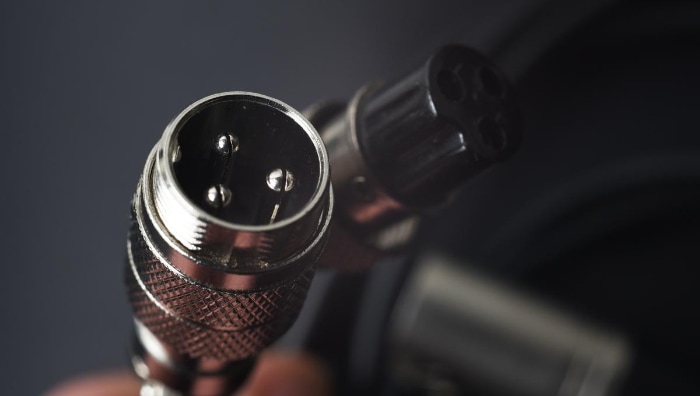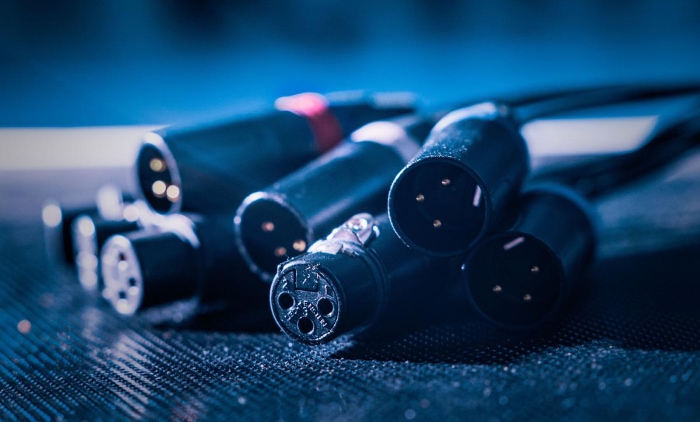XLR Connector: Advantages, Uses, and Why It Stands Out

XLR connectors may not make headlines, but their impact echoes in everything from your favorite rock concerts to high-end broadcasting studios. Often underestimated, these modest but potent components function as the backbone in the world of audio and visual technology.
By facilitating high-quality signal transmission and offering unparalleled robustness, XLR connectors have secured an indispensable role in various technological applications.
Technical Specifications
XLR connectors come with an array of technical features that make them a go-to choice for professional audio and video applications.
Pin Configurations and Functions
One of the most distinctive attributes of XLR connectors is the configuration of their pins. A standard XLR connector typically features three pins—Pin 1, Pin 2, and Pin 3. Each of these pins has a specific role to play.
- Pin 1: Ground or Shield
- This pin serves as the grounding for the entire circuit, reducing the chance of electrical noise interference.
- Pin 2: Positive or Hot
- Responsible for carrying the in-phase audio signal, this pin ensures the accurate transmission of sound.
- Pin 3: Negative or Cold
- This pin carries an audio signal that is 180 degrees out of phase compared to Pin 2, making it instrumental in achieving balanced audio transmission.
Material Composition
The composition of the materials used in manufacturing XLR connectors also contributes to their durability and performance. The outer casing is often made of robust materials like die-cast zinc, metal alloys, or high-impact plastic, offering excellent durability.
Internal components like pins are generally made of silver, gold, or other highly conductive materials, ensuring optimum signal transmission.
Electrical Characteristics
When it comes to electrical features, XLR connectors are known for their reliable performance metrics. These characteristics include:
- Impedance: Usually 110 ohms for audio applications, making them compatible with a variety of equipment.
- Voltage Rating: Varied based on the application, often exceeding 50 volts, thereby offering a flexible range for different use-cases.
- Current Rating: The current capacity can range from 3 to 15 amps, depending on the specific model and application.
Quality Factors
A crucial aspect often discussed with XLR connectors is the quality of signal transmission. Several factors contribute to this, including the internal wiring layout, shielding quality, and the absence or presence of additional filters to eliminate noise.
Common Uses of XLR Connectors
XLR connectors are not just versatile; they are almost ubiquitous in certain fields. Beyond the recording studio or stage, you’ll find them in a range of settings, each capitalizing on their specific strengths.
Audio Applications
Perhaps the most prominent application of XLR connectors lies in the realm of audio technology. Their balanced signal transmission makes them the ideal choice for:
- Microphones: In both recording studios and live performances, XLR connectors are often the default choice for microphones, offering both durability and high-quality signal transmission.
- Professional Audio Equipment: Mixing consoles, amplifiers, and other professional audio gear frequently employ XLR connectors to ensure a high-quality audio signal path.
Video Applications
While less common than in audio settings, XLR connectors are still crucial in video technology. They are often used for:
- Camera Feeds: Some high-end cameras use XLR connectors for external microphones or to connect to other types of professional video equipment.
- Lighting Rigs: In scenarios that require complex lighting setups, such as film sets or stage shows, XLR connectors can be used for sending control signals to lighting fixtures.
Data Transmission and Control Signals
XLR connectors are also employed in data transmission and for sending control signals, notably in:
- DMX Lighting Control: In theater and stage setups, XLR connectors are used to transmit DMX512 data signals for lighting control.
- Communications Systems: Some intercom systems used in event production or broadcasting employ XLR connectors to link communication stations.
Specialized Applications
Aside from audio, video, and data, XLR connectors have some unique applications:
- Industrial Equipment: In some instances, XLR connectors are used in industrial settings where a durable, locking connector is required.
- Medical Devices: High-end medical equipment that requires secure and high-quality signal transmission may also utilize XLR connectors.
Advantages of Using XLR Connectors

While there are various types of connectors available on the market, XLR connectors hold certain advantages that make them particularly well-suited for professional applications. These merits go beyond just robust design and reliable signal transmission.
Balanced Audio Signal Transmission
One of the standout benefits of using XLR connectors is their ability to transmit balanced audio signals. This means that they can effectively minimize noise interference, a critical factor in both studio recording and live performances.
- Noise Cancellation: By utilizing the phase inversion properties of balanced signals, XLR connectors can significantly reduce noise levels.
- High Signal-to-Noise Ratio: This makes XLR connectors particularly useful in situations where long cable runs are necessary, as they maintain a high signal-to-noise ratio.
Robust Physical Design
The physical attributes of XLR connectors also contribute to their popularity. They are built to last and can withstand the rigors of heavy use.
- Locking Mechanism: A unique feature is their locking mechanism, which ensures that the connection is secure, reducing the risk of accidental disconnection.
- Durable Materials: Often constructed from high-quality materials like die-cast zinc or metal alloys, these connectors are resistant to wear and tear.
Interchangeability and Compatibility
XLR connectors offer a high degree of interchangeability and compatibility, making them a flexible option for various setups.
- Standardized Design: The design is fairly standardized, meaning that an XLR connector from one manufacturer will usually be compatible with equipment from another manufacturer.
- Versatility: These connectors can be used for both analog and digital signals, making them versatile across different platforms.
Noise Reduction Capabilities
XLR connectors excel in reducing electromagnetic interference and are therefore widely used in settings where this is a concern.
- Shielding: The connectors typically include strong shielding, providing an additional layer of protection against external interference.
- Grounding Pin: The grounding pin (Pin 1) also plays a role in noise reduction by grounding the circuit.
Flexibility in Applications
XLR connectors are highly adaptable, serving not just in audio and video setups but also in more specialized applications like medical and industrial equipment.
- Multiple Pin Variants: While the 3-pin variant is most common, there are 4-pin, 5-pin, and higher pin-count versions for specialized uses.
- High Voltage and Current Ratings: Their high voltage and current ratings make them suitable for applications beyond just audio and video.
Differences Between XLR and Other Connectors
When it comes to connecting audio or video equipment, a multitude of connector types are available, each with their own advantages and limitations. XLR connectors stand out in several ways, and knowing how they differ from other connectors can inform better decisions for specific applications.
XLR vs TRS
TRS (Tip-Ring-Sleeve) connectors are often used in both consumer and professional audio applications. However, there are key differences:
- Physical Design: TRS connectors usually lack the locking mechanism found in XLR connectors, making them less secure for professional setups.
- Signal Transmission: While TRS connectors can also carry balanced signals, their effectiveness in minimizing noise interference is generally considered inferior to XLR connectors.
- Durability: XLR connectors are often more robust and better suited for heavy-duty applications compared to TRS connectors.
XLR vs RCA
RCA (Radio Corporation of America) connectors are common in consumer audio and video equipment. Here’s how they differ from XLR:
- Balanced vs Unbalanced: RCA connectors are unbalanced, which makes them less effective at minimizing noise interference compared to the balanced XLR connectors.
- Signal Quality: XLR connectors offer a higher signal-to-noise ratio, especially important for professional and live setups.
- Physical Security: The lack of a locking mechanism in RCA connectors makes them unsuitable for applications that require a secure connection.
XLR vs USB
USB (Universal Serial Bus) connectors are ubiquitous in computing but are also used in some audio interfaces and microphones.
- Digital vs Analog: USB connectors are primarily designed for digital data transmission, while XLR is most commonly used for analog signals.
- Power Supply: USB connectors can provide power to connected devices, something not usually possible with standard XLR connectors.
- Versatility: USB connectors are generally not suitable for long cable runs or for applications requiring balanced audio signals.
XLR vs HDMI
Though not commonly compared, HDMI (High-Definition Multimedia Interface) connectors are worth mentioning as they are often used in video applications.
- Signal Type: HDMI is designed for digital video and audio signals, making it fundamentally different from the analog or digital audio signals often transmitted via XLR.
- Data Channels: HDMI can carry both audio and video signals as well as control signals, whereas XLR is generally used for a single type of signal.
- Quality: XLR connectors excel in situations requiring high-quality, balanced audio transmission, something HDMI is not designed to prioritize.
Conclusion
Drawing together the multiple facets of XLR connectors reveals their irreplaceable role in various professional settings. These connectors distinguish themselves through their robust physical design, balanced signal transmission capabilities, and adaptability to diverse applications—from audio and video to specialized industrial and medical equipment.
When compared to other connector types like TRS, RCA, USB, and HDMI, XLR connectors consistently offer superior performance, particularly in environments that require high-quality, secure, and noise-free signal transmission. It’s no wonder they are the go-to choice for professionals seeking reliability and performance.


